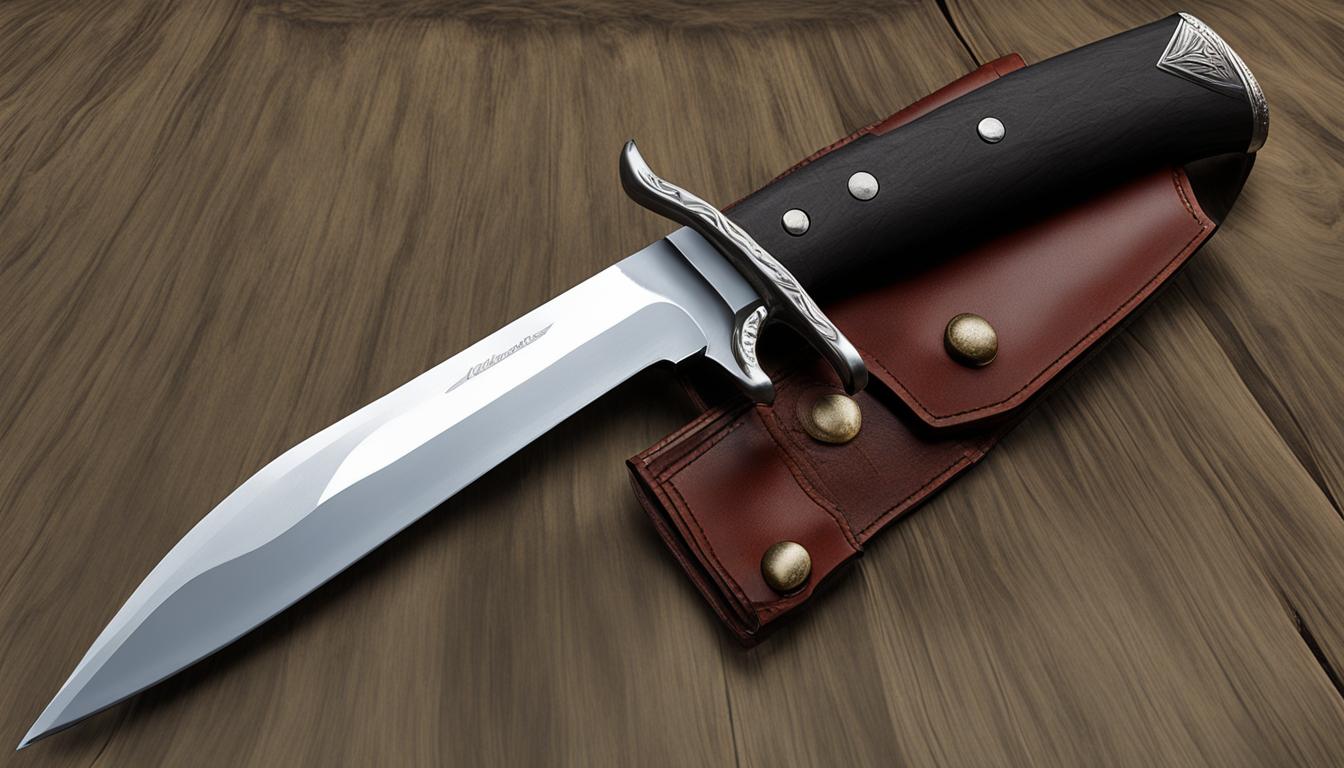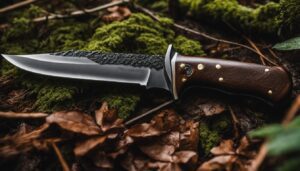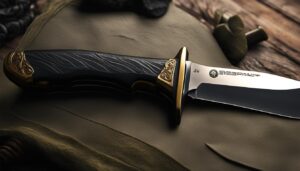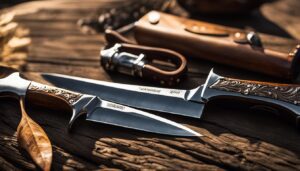As an avid hunter, I understand the importance of having the right tools by your side. And one tool that should never be overlooked is the hunting knife. But a great hunting knife is only as good as its sheath. That’s why I’ve put together this essential guide to hunting knives with sheaths, so you can make an informed choice when selecting the best option for your needs.
When it comes to hunting knives, the sheath plays a crucial role in protecting the blade, ensuring easy access, and withstanding the harshest conditions. Expert craftsmen recommend different styles based on personal preference and the type of hunting knife you have. But one thing they all agree on is the importance of using vegetable-tanned cowhide for its toughness and versatility.
Throughout this guide, we’ll explore the different types of hunting knives, the optional features to consider, and even take a trip through history to see how hunting knives have evolved over time. By the end, you’ll have a better understanding of hunting knives with sheaths and be equipped with the knowledge to make the right choice for your next hunting adventure.
Key Takeaways:
- Expert craftsmen emphasize the importance of finding the best hunting knife sheath for optimal protection, performance, and aesthetics.
- Vegetable-tanned cowhide is the preferred material for hunting knife sheaths due to its toughness and versatility.
- When selecting a hunting knife, consider how it will be used and whether a specialty knife or a multi-purpose knife is the best choice.
- There are various types of hunting knives, each designed for specific tasks, such as skinning, boning, or caping.
- Optional features to consider in a hunting knife include a gut hook and different blade styles like clip point, drop point, and skinning blade.
Choosing the Right Hunting Knife for Your Needs
When it comes to selecting a hunting knife, there are several key factors to consider to ensure you find the perfect tool for your needs. Whether you’re looking for a multi-purpose hunting knife or a specialty cutter for specific tasks, it’s important to choose wisely.
If you have specific tasks in mind, such as skinning or cutting branches, a specialty knife designed for that purpose may be your best bet. Options like boning knives, skinning knives, camp knives, and caping knives offer unique features tailored to these specific tasks. On the other hand, if you prefer a versatile all-in-one tool, a general-purpose hunting knife or a multi-tool with the necessary features can be a great choice.
Size also plays a role in your decision-making process. Consider the intended use and personal preference when selecting the size of your hunting knife. Smaller knives are more portable and maneuverable, while larger knives offer greater strength and cutting power.
| Type of Hunting Knife | Features |
|---|---|
| Boning knife | Narrow, flexible blade for easy meat removal from bone |
| Skinning knife | Short, thin, curved blade for precise skinning without tearing |
| Camp knife | Versatile multi-purpose tool combining attributes from other knives |
| Caping knife | Upturned point for skinning animal heads and necks for trophy creation |
| General-purpose hunting knife | Well-rounded features for various hunting tasks |
When it comes to the blade, you’ll want to consider the type of blade design, the material used, and the handle. Different blade designs offer distinct advantages, such as clip points for versatility and drop points for strength. High-quality blade materials, like stainless steel or carbon steel, ensure durability and sharpness. Lastly, the handle should provide a comfortable grip and be constructed from materials that can withstand the elements.
By carefully considering the intended use, size, blade design, materials, and handle of your hunting knife, you can choose the perfect tool to accompany you on your hunting adventures.
Exploring Different Types of Hunting Knives
When it comes to hunting knives, there are several different types that cater to specific tasks and preferences. Let’s take a closer look at some of the most popular hunting knife styles available:
Camp Knife
The camp knife is a versatile multi-purpose tool that combines attributes from other types of hunting knives. It typically features a large, sturdy blade that can handle various tasks, making it a great all-around option for camping and outdoor activities.
Bowie Knife
The Bowie knife, inspired by Jim Bowie’s modifications, is a large sheathed knife with a clip point blade. Known for its strength and durability, the Bowie knife became popular among hunters and is often favored for its ability to handle heavy-duty tasks in the field.
Caping Knife
Caping knives have an upturned point and are specifically designed for delicate tasks such as skinning the head and neck of animals for trophy creation. The upturned point allows for precise cuts without damaging the underlying hide.
Skinning Knife
For hunters who prioritize clean and efficient skinning, a skinning knife is an essential tool. These knives have short, thin, curved blades that are ideal for carefully cutting through the skin without tearing muscles.
Boning Knife
A boning knife is a narrow, flexible blade that excels at removing meat from bone. This type of knife is commonly used for field dressing or butchering game, allowing hunters to separate meat from bone with ease.
Buck Knife
The Buck knife, modeled after the iconic Buck Model 110 Hunting Knife, is a popular choice for hunters looking for a reliable all-purpose pocket knife. Its compact size and versatile design make it suitable for various tasks in the field.
Hunting Set
For hunters who require specialized tools for specific dressing or caping tasks, a hunting set is an excellent choice. These sets often include a combination of knives and tools tailored for different aspects of game processing.
Exploring these different types of hunting knives allows hunters to choose the most suitable tool for their specific needs. Whether it’s a versatile camp knife, a sturdy Bowie knife, a precise caping knife, or any other style, having the right hunting knife can make a significant difference in the field.
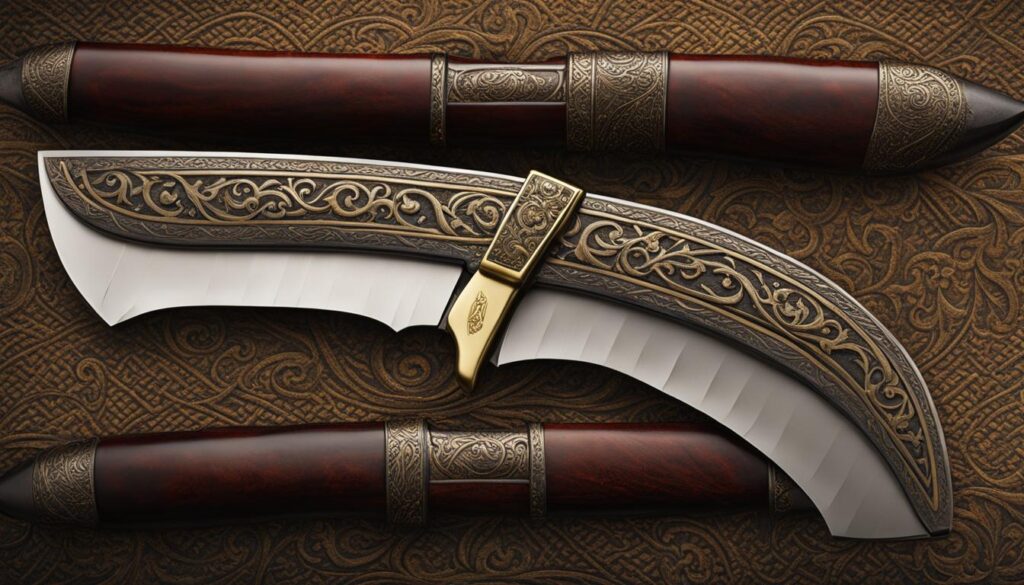
| Knife Type | Description |
|---|---|
| Camp Knife | A versatile multi-purpose tool with a large, sturdy blade. |
| Bowie Knife | A large sheathed knife with a clip point blade, known for its strength and durability. |
| Caping Knife | Designed for delicate tasks like skinning the head and neck of animals for trophy creation. |
| Skinning Knife | Features a short, thin, curved blade for clean and efficient skinning. |
| Boning Knife | A narrow, flexible blade used for removing meat from bone. |
| Buck Knife | A compact all-purpose pocket knife suitable for various tasks. |
| Hunting Set | A collection of specialized knives and tools for specific dressing or caping tasks. |
Optional Features to Consider in a Hunting Knife
When selecting a hunting knife, there are several optional features to consider that can enhance your hunting experience. These features can provide added functionality and convenience, depending on your specific needs and preferences.
“A gut hook feature allows hunters to easily open and dress game animals without piercing vital organs.”
One optional feature to consider is a gut hook. A gut hook is a small, curved blade located on the spine of the hunting knife near the tip. This feature allows hunters to easily open and dress game animals without piercing vital organs. The gut hook simplifies the field dressing process, making it quicker and more efficient.
| Gut Hook | Blade Style | Clip Point | Drop Point | Skinning Blade |
|---|---|---|---|---|
| ✓ | Clip point | ✓ | ✓ | ✓ |
| Drop point | ✓ | ✓ | ||
| Skinning blade | ✓ |
Another feature to consider is the blade style. Popular options include the clip point, drop point, and skinning blade. The clip point has a concave shape with a fine, sharp point, making it versatile for puncturing tasks. The drop point, on the other hand, has a slightly curved spine and a strong, broad tip, making it ideal for skinning. Lastly, the skinning blade is short, thin, and curved, perfect for precise cutting along the skin without tearing the hide.
Ultimately, the choice of optional features in a hunting knife depends on your personal preferences and the specific tasks you plan to perform. Consider what will best suit your hunting style and needs to ensure you have a reliable and efficient tool in the field.
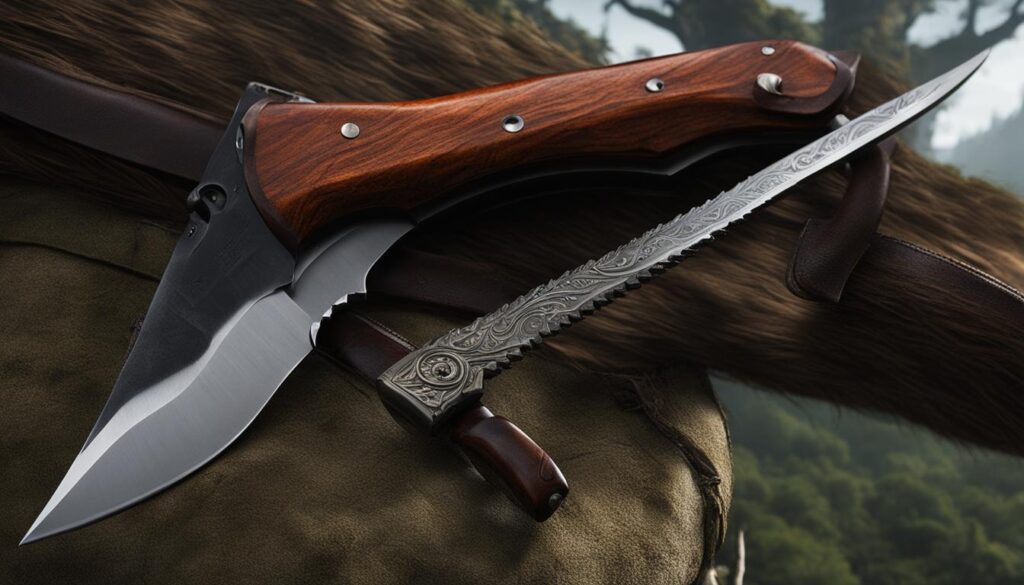

References:
- Understanding Hunting Knife Design
- How to Choose Your Hunting Knives
The History and Evolution of Hunting Knives
The history of hunting knives dates back to the Stone Age, when early humans relied on rudimentary tools made from stone, shell, or bone for hunting and survival. These primitive blades were essential for tasks such as butchering animals for meat and crafting other tools. As civilization progressed, so did the development of hunting knives.
One iconic figure in the history of hunting knives is Jim Bowie, who modified knives to suit his specific needs, creating what is now known as the Bowie knife. The Bowie knife gained popularity among hunters and trappers due to its versatility and durability. Its distinctive design, characterized by a long clip point blade, made it a formidable tool for hunters.
“The Bowie knife became a symbol of the frontier and was favored by hunters, adventurers, and even soldiers.”
Another significant milestone in the evolution of hunting knives was the Swiss Army knife, which popularized the concept of folding knives for hunting purposes. This versatile tool featured multiple blades and tools in a compact design, making it a convenient choice for hunters. The Swiss Army knife paved the way for the creation of the Buck Model 110 Hunting Knife, which became a best-selling knife cherished for its reliability and functionality.
One of the notable advancements in hunting knife design is the drop point hunter style, popularized by R.W. Loveless. This design features a strong and versatile blade with a lowered, convex spine, making it ideal for skinning and precision cutting. The drop point hunter design has become a classic choice for hunters, combining practicality and aesthetic appeal.
| Key Figures | Knife Type |
|---|---|
| Stone Age Humans | Primitive Stone Knives |
| Jim Bowie | Bowie Knife |
| Swiss Army | Folding Hunting Knife |
| Buck Knives | Model 110 Hunting Knife |
| R.W. Loveless | Drop Point Hunter |
The history of hunting knives is a testament to the ingenuity and innovation of humans throughout the ages. From the humble beginnings of primitive stone tools to the diverse range of hunting knives available today, these essential tools continue to evolve and adapt to the needs of hunters.
The Modern Definition and Uses of Hunting Knives
When it comes to modern hunting knives, their design and functionality have evolved to meet the demands of hunters in the field. These versatile tools are primarily optimized for cutting and slicing, making them indispensable for various tasks related to field dressing, gutting, skinning, deboning, butchering, and caping.
Field dressing is a crucial step in preparing game for consumption, and a hunting knife is essential for this process. Whether it’s field dressing a deer, elk, or any other animal, a sharp and reliable hunting knife allows hunters to efficiently remove the animal’s internal organs while preserving the meat. This requires precision and control, making a hunting knife with a sturdy blade and comfortable handle invaluable.
Skilled hunters also rely on their knives for gutting, which involves opening the animal’s abdominal cavity to remove its entrails. This task requires a sharp blade capable of cleanly cutting through tough tissues while minimizing the risk of puncturing organs. A hunting knife with a gut hook can further facilitate this process, providing a convenient tool for making quick and clean incisions.
“A hunting knife with a gut hook can further facilitate the gutting process, providing a convenient tool for making quick and clean incisions.”
Additionally, a hunting knife’s ability to skin an animal is crucial for preserving its hide. The process of skinning requires a knife with a blade that is both sharp and flexible, allowing hunters to carefully separate the skin from the animal’s body without damaging the hide. Skinning knives often have short, curved blades that excel in this task, ensuring a clean and efficient removal of the hide.
Table: Common Uses of Hunting Knives
| Gutting | Field Dressing | Skinning | Deboning | Butchering | Caping |
|---|---|---|---|---|---|
| Cutting through tough tissues while gutting animals. | Removing internal organs from game while preserving the meat. | Separating the skin from the animal’s body without damaging the hide. | Removing meat from bones, ensuring minimal waste. | Preparing meat for storage or consumption, including portioning and trimming. | Skinning the head and neck of animals to create hunting trophies. |
A hunting knife’s versatility extends beyond these primary tasks. From deboning meat to butchering game for storage or consumption, these knives prove indispensable in the hands of skilled hunters. Additionally, caping knives are specifically designed for skinning the head and neck of animals, allowing hunters to create trophies as a testament to their hunting prowess.
Ultimately, the modern hunting knife serves as a fundamental tool for hunters, offering them precision, durability, and versatility in the field. With their enhanced design and features, these knives have become an essential companion for any hunting expedition.
Conclusion
Hunting knives with sheaths are a crucial tool for hunters, offering protection, performance, and convenience in the field. The right sheath style, material, and design play a significant role in the overall functionality and durability of hunting knives. When selecting a hunting knife, it is important to consider personal preference, the style of knife, intended use, and blade features. By having a thorough understanding of the history, types, and uses of hunting knives, hunters can make well-informed decisions and choose the best options to elevate their hunting experience.
Investing in a high-quality hunting knife with a suitable sheath ensures that hunters have a reliable and long-lasting tool for their adventures. Whether it’s hunting knives with sheaths, sheathed hunting cutters, or a sheath for hunting knives, the right combination of features can enhance performance and make a significant difference in the field. Hunters should prioritize the protection and preservation of their knives by selecting the appropriate sheath that provides secure carry and effectively guards the blade and handle.
During the selection process, it is essential to consider the type of hunting knife, the specific tasks it will be used for, and the overall durability required. By keeping these factors in mind and choosing a hunting knife with a sheath that meets individual needs, hunters can confidently embark on their hunting journeys, knowing they have a reliable and well-protected tool at their side.
FAQ
What should I consider when selecting a hunting knife?
When selecting a hunting knife, it’s important to consider how it will be used, the type of tasks you’ll be performing, the size of the knife, whether you prefer a fixed blade or folding blade, the blade design, material, and handle.
What are the different types of hunting knives?
There are various types of hunting knives, including the camp knife, Bowie knife, caping knife, skinning knife, boning knife, Buck knife, and hunting sets that provide specialized tools for different tasks.
What are some optional features to consider in a hunting knife?
Optional features in a hunting knife include a gut hook, different blade styles such as clip point, drop point, and skinning blade. The choice of optional features depends on personal preference and the specific tasks the knife will be used for.
What is the history and evolution of hunting knives?
Hunting knives have a long history, dating back to the Stone Age. Jim Bowie’s modifications led to the popularization of the Bowie knife, and the Swiss Army knife later introduced folding knives for hunting. The Buck Model 110 and the drop point hunter design further enhanced the evolution of hunting knives.
What are the modern uses of hunting knives?
The modern hunting knife is primarily optimized for cutting and slicing. Its main uses include field dressing, which involves gutting, skinning, deboning, and butchering game, as well as caping for trophy creation. Some hunters also use specialized hunting daggers for hog hunting.
What should I consider when choosing a hunting knife sheath?
When choosing a hunting knife sheath, consider the sheath style, material, and design that contribute to the overall functionality and longevity of the hunting knife. Factors such as personal preference, knife style, intended use, and blade features should be taken into account.
